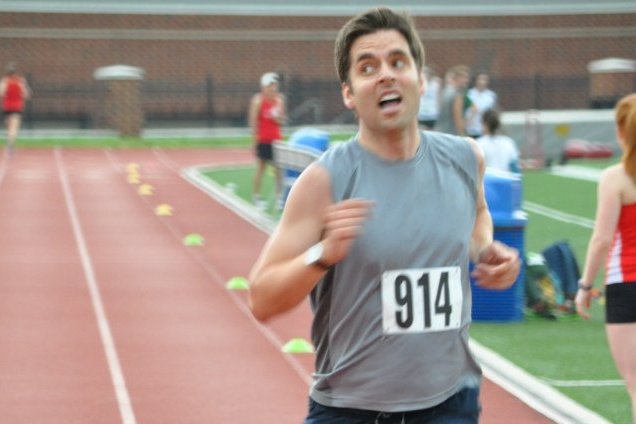
The fastest miler at the DC Road Runners One Mile and 3k Track Championships knew the area well, but a five-hour drive preceded his win.
Sandy Roberts broke the meet record (4:13.67, set in 2013 by David Chorney) with his winning time of 4:09:35 in the men’s elite heat.
[button-red url=”http://www.dcroadrunners.org/races/race-results/2014-results/2412-2014-dcrrc-track-championships-mile-heats.html” target=”_self” position=”left”] Mile Results [/button-red]Roberts raced collegiately for the Georgetown Hoyas, including an All-American status as part of the distance medley relay. He’d just arrived back in familiar territory from Raleigh, N.C.
His brother and coach, Logan, ran as a rabbit for the early part of the race. He said the mile proceeded as planned.
“Because he’s racing hard next week, we wanted to get a simulation, go through 1,000 at race pace,” Logan said. “He executed pretty well. Ideally, he would have been able to cruise a little more on that middle 400, but he had some competition.”
Roberts out-kicked Dan Quigley, of Eugene, Ore., in the final 200 meters to secure the victory.
“We’ve been working on the final kick,” Roberts said. “I think Dan’s a really talented runner. I didn’t know who that was, just like, holy cow, there’s someone here.”
The celebration will be short-lived for the Roberts brothers. They headed for the car after the meet to drive to a race in Charlottesville in preparation for Sandy’s shot at breaking an elusive track mark.
“All this is moving toward a sub-four mile attempt next Friday night in Raleigh,” he said. “Hopefully, in little over a week from now, I’ll have conquered a sub-four. That’s the goal.”
The new men’s meet record continues a trend of dropping times every year for the past three, said race director Brian Danza.
On the women’s side, Susanna Sullivan missed the meet record (4:48.70, by Alisa Harvey) by less than a second after an unusually short warm up.
Her professor granted her an absence for 80 minutes in the middle of a four-hour graduate class at Marymount University. In that short time, she traveled to the race, pulled on a bib and jersey, and proceeded to run away from the competition for a 4:49:65 finish and a win for the second year in a row at the championships.
“I was a bit surprised,” she said. “I thought it would hurt more. I knew what the record was, and I wanted to give it a shot. But when I got here and only had a couple minutes to warm-up, that basically went out the window and the goal was just to compete. It’s a track PR.”
Sullivan has run faster but did so on a road course with a slight downhill in Winchester.
“We’ll call this a legitimate PR,” she said, with a laugh. “I feel really good about it. I’m in the middle of marathon training right now. It’s real encouraging to see that I can turn over even when my body should be dead. I’ve been feeling really good throughout the marathon training.”
Sullivan has already qualified for the Olympic marathon trials with a B standard. She’s preparing for the Medtronic Twin Cities Marathon, in Minnesota, in what will be her first full 26.2 and an attempt at the Olympic A standard.
Her success was partially responsible for Sullivan’s excused absence.
“That was in the email today. ‘Hey, I qualified for the Olympic trials. Can I run a mile tonight?’ He was really understanding. This is always a really fun event. I’ll know next year I can’t have class on Wednesday.”
Due to conflicts with other Arlington County sites, this year’s meet was held at T.C. Williams High School track in Alexandria instead of the usual site at Washington-Lee High School in Arlington.
Danza estimated the move created a 20- to 30-percent drop in participation but that the competitive races still pleased him.
“We had a great night,” he said. “I think it’s an event that caters to people who like running for the race aspect. They can come here, toe the line, and go out really hard for four minutes for the elite guys or seven minutes for some other people, and push themselves.”
Track meets don’t happen in the DC metro area as often as garden-variety 5ks or even nationally known marathons.
That’s what makes the meet so important.
The future stars opened the night in the kids mile, and several returned to the start line to run against women their mother’s age and men with white hair in the various heats of the mixed miles that ran before the elites.
Other athletes jumped into the four-lap test wearing everything from compression club kits to cheap shorts and race shirts from area events.
“Coming to a mile and going all out is a good way to determine how fit you actually are,” Danza said. “It’s a good place for local runners to come run a fast mile.”
Will Viviani said the fitness aspect appealed to him.
“I didn’t know where I was fitness-wise,” he said. “I wanted to see where everyone else was before I made a move.”
Viviani pulled into first with 300 meters to go and ran to the heat win in 4:35.96. He used the race as a way to jump back into competitive racing after a hiatus from hard training of more than two years.
Other racers learned how the mile can dish out disappointment. Ben Garthwaite tried to break five minutes in his heat.
“I was on it through three laps,” he said. “I knew it when I tried to kick it in at 200. I’m like, OK, you just need to finish hard and you got this. My legs just didn’t do what they were supposed to.”
He crossed the line in 5:01.80 behind the heat winner Mark Walchinsky, who did break five minutes, in 4:58.07.
“That was the goal in the back of my head,” Walchinsky said, “but if I didn’t break five, that was cool. But I actually met my expectations. It was a short enough race that the humidity didn’t come in and kick me like it does if you do a half marathon in these conditions.”
Eunja Rau won the master’s division for women in her first track mile in 8:30.34. She’s getting ready for the Marine Corps Marathon, which will be her first at that distance.
“i’ve done some track training, but not just the one mile,” she said. “It’s always hard to run fast, but it was doable because it was short.”
Rau started running two years ago when she met members of the DC Road Runners club at a library event for a couch-to-5k program.
And in the spirit of the track championships, Rau not only raced but also volunteered during the meet, giving back as much as she’s receiving from the sport.
Over five weeks this spring, Susanna Sullivan ran four races.
A nation-leading 26:51 at the St. Patrick’s Day 8k. A week later, second at Virginia Beach’s Shamrock Half Marathon in 1:14:22. After a break, second at the Collegiate Running Association championships at Richmond’s Monument Avenue 10k with a 33:42, a pace she nearly matched eight days later en route to a 54:31 finish at the Cherry Blossom Ten Mile, fourth place in the U.S. 10 mile championship race.
Two years ago, that would have been unthinkable. Not the times, but running two races, let alone four, in five weeks.
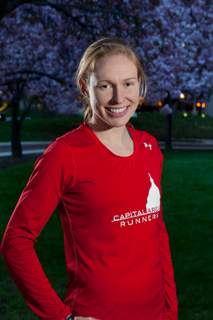
“I got so used to being hurt that if someone would talk about a race a month away, even if I was healthy, I could never get my hopes up or realistically think I’d be able to race it,” she said. “Even my first year after college, I expected to be broken in half a week later.”
But it didn’t happen, and now she has a race on her calendar more than a just few weeks away — Feb. 13, 2016 in Los Angeles– the U.S. Olympic Marathon Trials. Her time at Shamrock — the race she thought was the worst in that stretch — won her an invitation, and as she approaches two years since her post-collegiate running career began, she’s enjoying training consistency she hadn’t known since she left for Notre Dame.
Following her successful career at George Mason High School, she had every reason to expect dramatic improvement.
“I assumed I’d have people to run with, and with their coaches and facilities, I thought it would be perfect, being surrounded by people who were competitive,” she said. “It didn’t turn out to be what I expected.”
While her times did improve, it wasn’t a smooth ride. As injuries invariably followed her good training weeks, she broadened her life away from the track so that the times she’d be forced from it wouldn’t be as distressing. With a few months to go before graduation, a broken foot sidelined her for most of her last semester, but the way she answered set the stage for her future.
“I figured I could mope around with a broken foot and wear a boot at graduation, or see what I could do,” she said.
Sullivan put in several hours a day in the pool and the Alter-G treadmill, working like a maniac, as she put it. All for the hopes of a few more chances to race. Not the routine of a senior who had checked out.
And it paid off. She ran at the Big East championship meet and scored her only collegiate victory at her final race –at Grand Valley State — before coming home to Falls Church with physiological momentum but emotional uncertainty.
Desperate to break out of her malaise, wanting to run fast but shy of putting herself out there again, she considered transitioning to running for fun, maybe picking up ballet and French classes, but she couldn’t see herself putting running too deeply into the background.
“I love running more than anything in the world,” she said. “I thought that maybe, when running is just fun, when there are no expectations, it would stop being so frustrating,” she said. Soon after coming home, she joined the Capital Area Runners and found coach George Buckheit‘s approach to be exactly what she needed.
“He knew where I was coming from — a place of deep frustration,” she said. “Everyone has fun at CAR, but he made sure I stayed relaxed.”
Buckheit also saw what the problem was, and how her spring led her on the way to fixing it.
“Like many distance runners, she would always pound herself until she got injured and she was injured frequently,” he said. “She did way too much anaerobic work and had way too few recovery days built into her training.”
Her first summer, she committed to building an aerobic base, one she found herself missing when she tried frantically to catch up following collegiate injuries.
“It was a bit of a battle to convince her that she could race a lot faster if she simply slowed down her training but did more of it, but she’s become more and more confident with that approach as she’s continued to see her PRs improve,” Buckheit added. “Even though she’s almost doubled her total weekly training volume, she’s putting less total stress on her body by pulling back on the anaerobic work and making sure that her recovery days truly are easy aerobic days.”
Within her first few weeks, Sullivan was cashing in that time she banked in the pool and on the treadmill, taking off immediately in her new training environment.
“I didn’t even look at the workouts until I got to the track, there were very competitive people, but nobody takes it over the top. It was so refreshing,” she said. “I was sold from day one.”
All the while, she’s been spending her days on her feet as a kindergarten teacher in Fairfax County.
“I’ve wondered if it’s good for running, bad for running or neutral, and I’ve come to the conclusion that it benefits (running),” she said. “I read about how sitting is crummy for everything. Steps divide our classroom — it’s like I do box steps all day.”
She relishes working with her co-teacher, whom she calls “a master of kindergarten.”
“I love early brain development and it’s really cool to watch the kids put it together, make the little connections and see them become big connections,” she said.
Sullivan has put a few things together, too.
Her first half marathon — the 2012 Rock ‘n’ Roll Philadelphia Half — was long enough to seem like a challenge, but her sub 1:20 time convinced her, and Buckheit, that she had an aptitude for long distances. Over the next year, she set PRs in every distance and became a regular on local podiums. During her return to Philly in 2013, she took a swing at the Olympic Marathon Trials B standard half marathon time of 1:15. A side stitch in the last mile kept her from closing, but in the process she topped local Olympic 5k runner Julie Culley and marathon trials qualifier Christine Ramsey.
From there, she focused on Shamrock, in March 2014, set on solving that last mile and earning her ticket to the trials. Memories of rough half marathons before dogged her, but she was fortunate to miss the savage ocean wings that plagued marathoners later that morning.
“I feel so blessed that the worst race (in her five-week spring season) would end up as a trials qualifier,” she said. “I felt like I was uptight the whole race, I didn’t know when I’d “have it.’ But, when I was two miles from the finish, I thought I’d really have to screw this up.”
Ahead of Cherry Blossom, Buckheit told her not to be surprised if she was running her 10k pace. When Sullivan found the pack of Americans chasing eventual champion Janet Bawcom and Sarah Hall, she thought it “was cool to be racing with these women who were pretty good,” including national-class runners Frances Koons, Brianne Nelson and three-time Olympian Jen Rhines.
“I felt like it was inevitable that I was going to be dropped, but the longer I held on, the better my time was going to be,” she said. “At five miles, I knew I could hang in until eight. With just under a mile to go, I thought I would give it a shot. I wasn’t pulling away too much. I don’t know why I made a move.”
Though she lost to Koons in a kick, she finished ahead of Nelson and Rhines, and probably made the difference between fourth place and farther back in the pack.
“George told me to be brave, and that’s been the theme the past month — getting in and rolling with girls I don’t think I can race with,” she said.
Now she sets her sights on the big one — the marathon. She’s going to try it out before the Olympic Trials, and plans on October’s Twin Cities Marathon. As she advanced her mileage, she scratched 95 miles a week earlier in the year, to see how her body reacted and give her a preview of training for 26.2 miles.
“The marathon, I wasn’t really sold on it until this string of races,” she said. “At this point I trust anything that comes out of George’s mouth. If he says I can do it, I’m going to try.”
This story originally appeared in the May/June 2014 RunWashington.
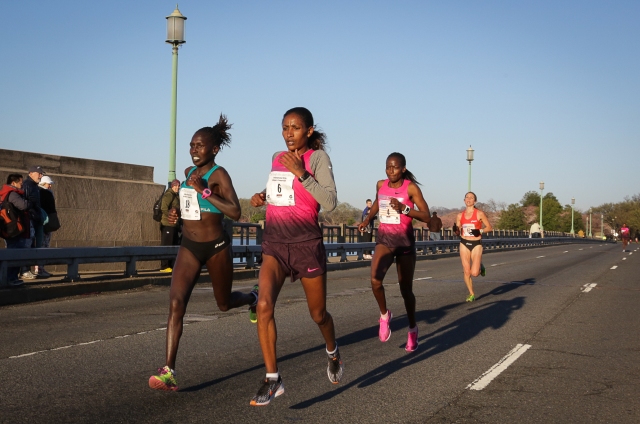
Janet Bawcom weighed her effort at the Cherry Blossom Ten Mile on going for the overall win and although she ran out of room to catch Ethiopian Mamitu Daska, she still came away with another national title and 52:12 finish that lopped 1:16 off the American Record she set last year, when she finished fourth.
[button-red url=”http://www.runwashington.com/wp-content/uploads/2014/04/CB-2014.pdf” target=”_self” position=”left”] Results [/button-red]”I just wanted to run hard and be competitive in the race as long as I could. It worked out. Last year, I was alone on that straightaway from mile six to seven, running into the wind,” she said. “This year, I told myself that no matter what I did, I couldn’t be alone out there. If it meant hurting to catch up to someone else, it would be better than hurting on my own later. It’s going to be the same amount of pain, so I might as well hurt more early and run faster.”
Daska and Aliphine Tuliamuk–Bol would surge away when Bawcom would edge up to them, and Bawcom spent time catching up before the cycle would repeat. When Daska made a surged in the last mile, Bawcom tried to keep things going, but wasn’t able to chase her down before Daska broke the tape in 52:05,for a seven-second margin.
Bawcom, along with second U.S. finisher Sara Hall, live in Flagstaff, Ariz. Hall, who has made much of her racing reputation on the track, had run a competitive half marathon and less-than competitive 15k, but felt adjusted to the 10 mile distance as she explores her longer-race options.
“I still plan to run on the track this year, as short as the mile, but I am eyeing the marathon in the near future,” she said.
Having come back from training at 9,000 feet in Ethiopia, she “felt really strong down at sea level,” she said. “I debated between running with the leaders or focusing on the U.S. race, but I decided to go for it and I’m glad I did.”
Finishing in 52:54, she ran under the previous American record.
Hall encountered a lot of the surging that Bawcom did, and wound up on her own the last five miles.
“Not ideal when you’re used to being on the track, but I’m getting better at it. Mentally, it can be easier because you’re not running in circles. That, I enjoy.”
Philadelphian Frances Koons ran what she called one her best races to finish as the third American.
She started as a miler in high school but is finding longer distances to her liking.
“I was injured a lot in 2012 and I spent a lot of last year getting back together, so this year I’m starting to see things coming back on track,” she said. “I feel strong and I’m excited about running. I kept telling myself to think about 400 meters to go.”
Susanna Sullivan of Falls Church finished fourth in the U.S. championship race and eighth overall, capping a stretch in which she ran what was at the time the fastest women’s 8k time at the St. Patrick’s Day 8k, qualified for the U.S. Olympic Marathon Trials at the Shamrock Half Marathon in Virginia Beach and finished second, to habitual D.C.-area racer Kellyn Johnson Taylor, at the Collegiate Running Association Championships in Richmond.
“It’s been a lot to get a handle on,” she said, after running 54:31 compared to last year’s 58:41. “It’s happened so fast, just a few weeks.”
That improvement was part physiological development, part racing maturity.
“George (Buckheit, her coach) told me I just have to be brave and go for it,” she said. “Last year I didn’t, I played it safe.”
She’s looking forward to a few down weeks now.
Another local runner, Jen Bergman, had only been local for six days, having moved to Washington the prior Monday. Like Hall, she was making a transition to the roads, from her track background at the University of Arizona. She finished 25th in 57:13.
“Well, that was almost twice as long as I had raced before,” she said. “It was nice and flat so I liked that. I haven’t even been around long enough that I’d run down here yet, but I think I’m going to like living here.”
U.S 10 Mile Championships (gun times)
1. Janet Bawcom 52:12
2. Sara Hall 52:54
3. Frances Koons 54:30
4. Susanna Sullivan 54:31
5. Brianne Nelson 54:33
6. Jen Rhines 54:38
7. Heather Cappello 54:40
8. Meghan Peyton 54:42
9. Sara Slattery 54:14
10. Blake Russell 55:26
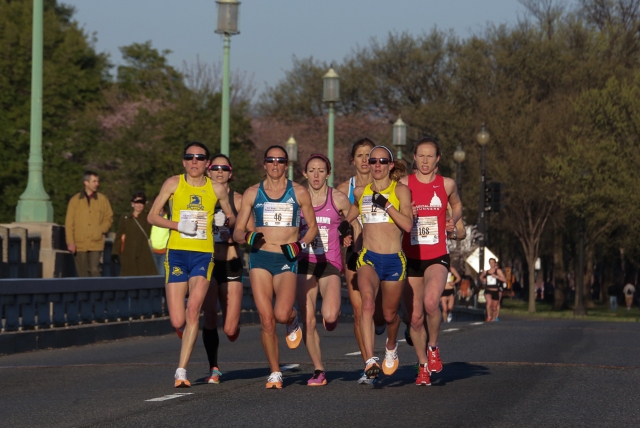
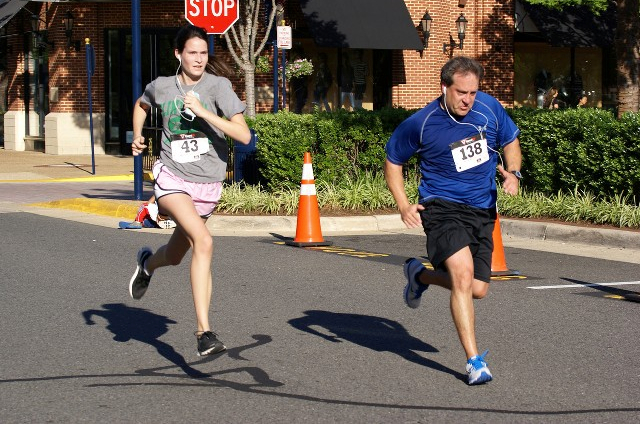
Sunday morning, the only crime was that more people weren’t out racing on one of the most pleasant days of the summer. With temperatures in the 60s on an August weekend that is accustomed to heat and humidity, the nearly 200 runners who showed up to the inaugural Fairfax County Crime Solvers 5k at Fairfax Corner.
The race supported Fairfax County Crime Solvers, an independent nonprofit that pays for rewards leading to the arrest of criminals in Fairfax County. Board member Jody Donaldson knew Cheryl Young of the Capital Area Runners team, which was interested in conducting a race. The team had 38 runners race and more than 15 volunteer.
[button-red url=”https://runsignup.com/race/results/?raceId=3638″ target=”_self” position=”left”] Results [/button-red] [button-red url=”http://youngrunner.smugmug.com/Race-Photo-Galleries/Crime-Solvers-5k-2013″ target=”_self” position=”left”] Photos [/button-red]
The great weather and fast opening mile by early leader, Falls Church’s Chris Mills (4:38), helped propel Pat Fernandez to a 15:30 win, by 15 seconds, over Mills. Arlington’s Bennett Stackhouse finished third in 16:46. All three are CAR runners. Fernandez, of Alexandria, pulled away halfway through the race and held his lead over the mostly-uphill third mile.
“It’s a lot better to race this course today than in your typical August Virginia weather,” he said. “We went out a little fast but held it together alright.”
Women’s winner Susanna Sullivan’s only challenge was avoiding a fellow runner listening to music who weaved all over the course. Sullivan, of Falls Church, sped to an easy 17:30 victory, with a 42-second margin over Elizabeth Knize of Midlothian and third place Katie Sheedy of Washington (18:56). Sullivan and Sheedy run for CAR.
Though the dozens of CAR runners already knew one another, the race was also an opportunity for people to make new friends. Ann Hennigan of Oakton started out the race faster than she thinks she should have, and Phyllis Calloway of Leesburg eventually caught up with her. The pair ran most of the race together, encouraging each other throughout.
“We didn’t know each other, but we helped each other,” Hennigan said.
Calloway’s strategy worked for the rolling hilly course.
“I like to walk up the hills and run down,” she said.
Hennigan agreed. “I I can fall down the hill faster than I can walk down, so that worked for me,” she said.
Phyllis Hennigan got into running after hears of invitations from her husband, Joe.
“He still has fun running.” Phyllis said. “I’m a walker/runner, but it’s been good for my health.”
Runners didn’t have to be pressing for the win to appreciate the cool weather. Robert Gaines of Clarksville , Md. was happy to find a mild race where he could work on his goal of averaging 10 minute miles.
“There was a lot of guidance on the course, and even though it was hilly, it wasn’t too rough,” he said.
Fairfax County Crime Solvers 5k * Aug. 4, Fairfax Corner, Va.
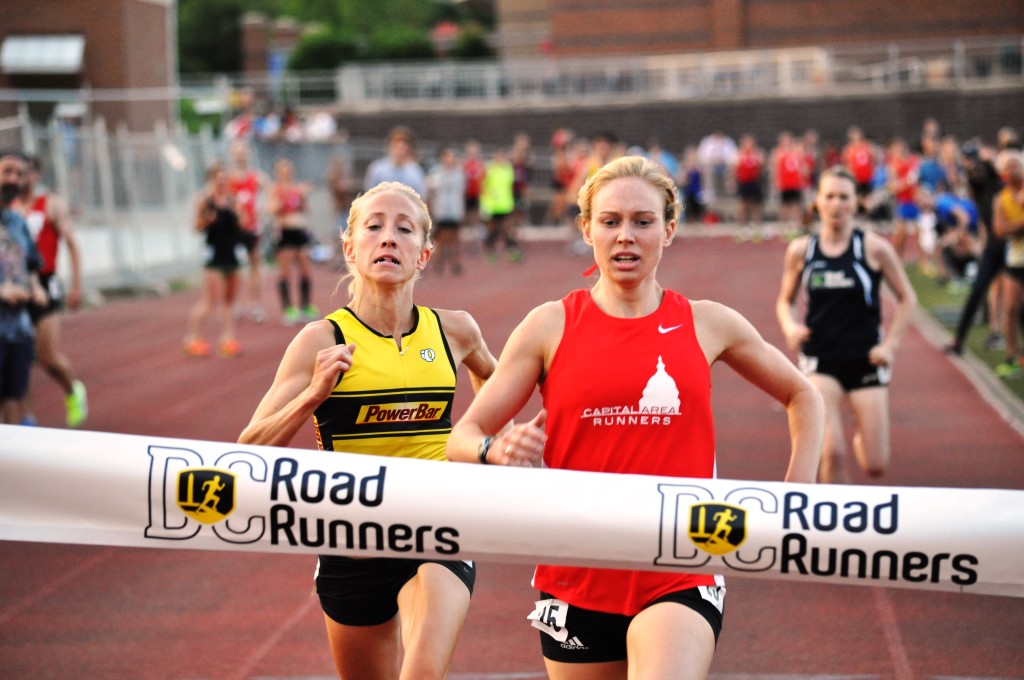
Track isn’t over once you leave school.
There might not be as many opportunities to race on the track as there are on the roads, but the DC Road Runners Track Championship remains a mid-summer option with some panache. And some shock for the legions of marathon runners who switch it up for an evening. The race tactics on display for everyone to see throughout the entire meet, the consistent lap splits and the energizing sound of the bell on the final lap, all of the elements of great track races were on display at Washington-Lee High School.
No more dramatically than during the elite women’s mile. Making a move with a lap to go, Susanna Sullivan pulled away from Kristin Anderson and Claire Hallissey and seemed ready to stake her claim to first place. Anderson wasn’t done, though, and gave one last effort before falling just a hundredth of a second short at the finish line, with Sullivan taking the win in 5:00.0.
The Falls Church resident, who finished second in the same race last year and won the 2012 3k race later that evening, was nervous before the race.
“I know it’s weird to be nervous before something so short, but it got better as soon as the race started,” she said. She had no idea how close Anderson was until the finish.
Sullivan will focus on the Rock ‘n’ Roll Philadelphia Half Marathon in September. She was one of 61 of Capital Area Runners athletes who bathed the track in red.
David Chorney came from Boston to visit his girlfriend in Arlington, and while he was here, picked up a comfortable 4:13.67 win in the men’s mile against Germantown’s Joe Wiegner, who held off Arlington’s Chris Mills, 4:17.18 to 4:17.7. A graduate of Muhlenburg College in Allentown, Pa., Chorney will return to eastern Pennsylvania to race the Lehigh Valley Marathon in September, right before registration opens for the Boston Marathon. Chorney runs for the Boston Athletic Association and needs a qualifier.
The track meet had 14 heats of mile races, which allowed runners to seed themselves for exciting and challenging races.
Anthony Lambkin of Arlington tore through his heat to finish second in 5:11.49. The race itself was straightforward compared to his usual conditioning — touch rugby (it’s apparently very popular in the D.C. area). The Australian native got into running three years ago thanks to his fiancé, Mary Doman. He has since run a marathon, a half and a smattering of 5ks.
“I don’t feel great now that the race is over, but I enjoyed it,” he said. “That last lap hurt.”
Doman didn’t have that problem, cruising through her heat to win in 6:12.03.
“I didn’t run in the right heat, but I really didn’t feel like coming in last today,” she said. “That’s no fun.”
Jennifer Adams was another Massachusetts resident who ran away with a mile heat victory. Between school years coaching cross country at Mount Holyoke College, she spends the summers in Maryland with her boyfriend and runs with the Capital Area Runners.
“I went out a little fast today,” she said. “My PR in the 400 is 68 seconds and I was out in 73. I was all over the place. Longer races are more my thing, more time to think.”
Her three-second victory in 5:17.12 at least gave her a few seconds for thoughts.
Chris Carney of Falls Church used the race as a comeback from a series of injuries including plantar fasciitis and a quadriceps tear. He’s aiming for the Marine Corps Marathon.
“It felt good to get out there,” he said. “It’s much different than a lot of races I run.”
[button-red url=”http://www.dcroadrunners.org/races/race-results/2013-results/2103-2013-track-championship-mile-heats.html” target=”_self” position=”left”] Mile Results [/button-red] [button-red url=”http://www.dcroadrunners.org/races/race-results/2013-results/2104-2013-track-championship-3k.html” target=”_self” position=”left”] 3k Results[/button-red] [button-red url=”http://youngrunner.smugmug.com/Race-Photo-Galleries/DCRRC-Mile-3k-7-24-2013″ target=”_self” position=”left”] Photos [/button-red]
Claire Hallissey wasn’t expecting to run an event record Saturday during the Lawyers Have Heart 10k.
“I did a track workout on Thursday,” the 2012 British Olympian said.
Yet the 30-year-old Arlington resident still ran a 34:33, bettering the previous event record by 9 seconds on a cool, overcast morning in Georgetown.
In fact, Hallissey and second place finisher Susanna Sullivan of Falls Church are only the second and third women to break 35 minutes in the event’s 23-year history, taking advantage of the good, June running conditions.
“She turned it on the last mile and just blew me away,” Sullivan, 23, who won last October’s Marine Corps 10k, said.
Sullivan finished in 34:48, just off the previous event record of 34:42 set in 1992 by Baltimore’s Charlotte Thomas.Wayinshet Hailu, 26, came in third at 36:06.
Event organizers called the 1992 10k course much more difficult than Saturday’s having trekked through many more hills around Georgetown’s residential areas.
The course has changed several times in the event’s history. This year’s started on K Street under the Whitehurst Freeway in Georgetown. Runners looped up to the freeway, ran down Canal Street, and turned back near Georgetown’s reservoir.
Hallissey’s appearance on Saturday took runners and event organizers by surprise, not expecting the Olympian, who turned in a 2:35:39 marathon in last summer’s London games, to run.
“I’m happy with how I’m running right now,” Hallissey said, noting her last few 10ks were in the 34-minute range.
Sullivan was trying to sneak up on Hallissey after a slower start and moved just a few strides behind her at the race’s turnaround point near the reservoir.
At that point, Capital Area Runner teammate and men’s leader Chris Mills shouted encouragement, seeing her in second place.
“Then, it was game over,” Sullivan said, referring to Hallissey’s talent and experience. “I had to show my cards.”
Hallissey said later she knew a female competitor was on her heels from the crowds yelling support to those behind her.
Mills, who went on to win the men’s race, called the high 60 degree weather at the start the “perfect temperature.”
Mills of Falls Church broke away from the pack after about 3.5 miles and cruised to a time of 31:15, better second place finisher Birhanu Mekonen by 26 seconds. Dave Burnham of Arlington came in third place with a 32:03.
The men were well off their event record of 29:51 set by Ethoipia’s Gurmessa Kumsa in 2006.
Mekonen and Hailu said after the race they were hampered by a late arrival to the race site and didn’t have a chance to conduct their full warm up.
Mills was proud of his running even splits, coming through the 5k at 15:38. The 23-year-old expected to run a great time, following a 29:09 performance at April 20’s Pike Peek 10k in Rockville.
Women’s fourth place finisher Barbara Fallon Wallace ran a 36:33 and called the conditions a bit muggy. The 39-year-old won last year’s race just 18 months after giving birth to twins.
“At least it was cloudy,” Fallon Wallace said. “It could have been 90 degrees.”
In fact, extreme temperatures two years ago caused organizers to shorten the race to a 5k.
But the event hosted a 5k – aside from 2011’s impromptu change – for the first time in several years in 2013.
The Capital Area Runners dominated the women’s side, taking the top three spots. Erin Taylor, 31, of Arlington led the way with an 18:08, followed by Ashley Kollme of Chevy Chase in 19:07 and Mary Christopher of Washington in 20:32.
“Whenever you can get your teammates in the top three, that’s great,” Taylor said.
Jack Riely, 19, of Silver Spring won the men’s 5k in 16:38.
Kristi Markowicz, 43, of Arlington was the women’s masters winners with a time of 39:13. Edmund Burke, 43, of Burkesville, Md. won the men’s masters race in 33:27.
The event, held annually since 1991, benefits the American Heart Association. Flocks of the law firms around the area organize teams to generate money for the group. So far, the event has raised more than $8 million for the cause.
So far this year, teams have raised in excess of $750,000, according to the event’s website. McDermott Will & Emery raised nearly $20,000 as of Saturday.
“It’s just nice to see some law firms — who don’t have a reputation for promoting the common good — have one Saturday where we’re out for the common good,” Jones Day attorney Ben Katz, 28, said following the race.
His firm raised more than $2,600 for the American Heart Association.
“In the legal community you hear a lot about people who have heart disease,” Jones Day’s Owen Conroy, 30, said. “It’s just nice to show support.”
The backs of Krooth & Altman’s bright yellow team shirts read “Run to remember, Run to Prevent,” an ode to the event’s well-being message.
“A lot of us have had family members or friends we’ve lost to heart disease,” paralegal Kelly Behr said.
The grandfather of Jonathan Singer, 29, of O’Melveny & Myers had a stroke, and building awareness for that was important to him.
“We want to serve the community in a legal capacity, but also give back,” Singer said, adding he ran his first ever road race Saturday, finish the 5k in 32:06.
His team had about twice as many people run this year with about 32 runners.
Many area attorneys run merely for the camaraderie.
“We’ve done this four years now, and every year have doubled in sized,” Paul Brinkman of Quinn Emanuel said.
Lawyers competed in teams of based on law firm size and practice type. Individuals competed for awards based on time in categories such as private practice, corporate lawyer, government lawyer, non-lawyer legal professional, paralegal, law student, and summer associate.
[button-red url=”http://results.bazumedia.com/event/results/event/event-4393″ target=”_self” position=”left”] Results [/button-red]

